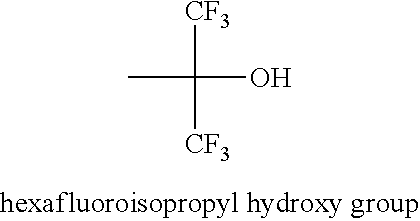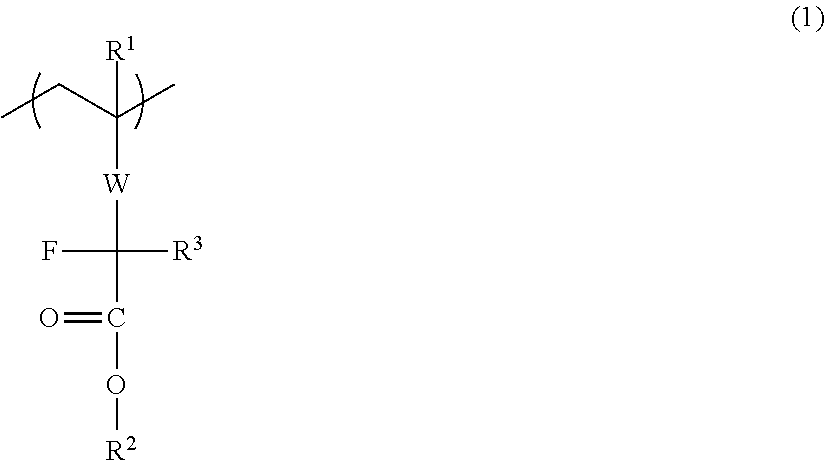Top Coating Composition
a top coating and composition technology, applied in the field of photoresist top coating composition, can solve the problems of film loss of the resist layer of the underlayer, deterioration of photoresist properties, and defect of formed resist patterns, so as to improve water repellency, improve water repellency, and improve the effect of top coating water repellency
- Summary
- Abstract
- Description
- Claims
- Application Information
AI Technical Summary
Benefits of technology
Problems solved by technology
Method used
Image
Examples
example 1-1
Method for Producing 2,2-difluoro-3-hydroxypentanoic acid ethyl ester
[0172]
[0173]A 500 mL reactor was charged with 24.2 g (370 mmol / 1.5 equivalents) of an activated metal zinc and 300 mL of THF (dehydrated), and thereto an ethyl bromodifluoroacetate / THF solution [51.47 g (253.6 mmol / 1.0 equivalent) of ethyl bromodifluoroacetate and 80 mL of THF (dehydrated)] was added dropwise. After the dropping, stirring was conducted at room temperature for 20 minutes. Then, a propionaldehyde / THF solution [14.80 g (254.8 mmol / 1.0 equivalent) of propionaldehyde and 80 mL of THF (dehydrated)] was added, followed by stirring at room temperature for 30 minutes. Then, water and diisopropyl ether were added to conduct a two-layer separation. The obtained organic layer was washed with diluted hydrochloric acid and water, followed by removing water by magnesium sulfate, conducting a filtration, and distilling diisopropyl ether out, thereby obtaining 41.2 g of the target 2,2-difluoro-3-hydroxypentanoic ac...
example 1-2
Method for Producing methacrylic acid 1-ethoxycarbonyl-1,1-difluoro-2-butyl ester
[0177]
[0178]A 300 mL reactor was charged with 18.0 g (98.4 mmol) of 2,2-difluoro-3-hydroxypentanoic acid ethyl ester, 78 g of chloroform, 120 mg of an antioxidant NONFLEX MBP (a product of Seiko Chemical Co., Ltd.), 12.4 g (118.8 mmol / 1.2 equivalents) of methacrylic acid chloride, and 15.0 g (148.8 mmol / 1.5 equivalents) of triethylamine, followed by stirring at 55° C. for 4 hours. Then, 120 g of water was added, followed by extraction with chloroform one time. The obtained organic layer was washed with diluted hydrochloric acid and water, followed by removing water with magnesium sulfate, conducting a filtration, and distilling chloroform out, thereby obtaining 24.7 g of the target methacrylic acid 1-ethoxycarbonyl-1,1-difluoro-2-butyl ester. Upon this, purity was 66%, and yield was 66%.
Properties of methacrylic Acid 1-ethoxycarbonyl-1,1-difluoro-2-butyl ester
[0179]1H NMR (CDCl3) d 6.14 (s, 1H; methylen...
example 2
Method for Producing methacrylic acid 1-hydroxycarbonyl-1,1-diffuoro-2-butyl ester
[0181]
[0182]A 2 L reactor was charged with 80.0 g (purity 66%), 208 mmol) of methacrylic acid 1-ethoxycarbonyl-1,1-difluoro-2-butyl ester and 80.0 g of water, followed by cooling down to 0° C., adding dropwise 84.8 g (320 mmol / 1.5 equivalents) of 15 wt % sodium hydroxide aqueous solution, and stirring at room temperature for 1 hour. The reaction liquid was washed with 800 g of diisopropyl ether. The obtained aqueous layer was washed with diluted hydrochloric acid, followed by extraction with diisopropyl ether two times, removing water by magnesium sulfate, conducting filtration, and distilling diisopropyl ether out, thereby obtaining 15.2 g of the target methacrylic acid 1-hydroxycarbonyl-1,1-difluoro-2-butyl ester.
Properties of methacrylic acid 1-hydroxycarbonyl-1,1-difluoro-2-butyl ester
[0183]1H NMR (CDCl3) d 7.24 (br, 1H; COOH), 6.16 (s, 1H; methylene), 5.63 (s, 1H; methylene), 5.39 (m, 1H; CH—O), 1...
PUM
| Property | Measurement | Unit |
|---|---|---|
| wavelength | aaaaa | aaaaa |
| wavelength | aaaaa | aaaaa |
| refractive index | aaaaa | aaaaa |
Abstract
Description
Claims
Application Information
 Login to View More
Login to View More - R&D
- Intellectual Property
- Life Sciences
- Materials
- Tech Scout
- Unparalleled Data Quality
- Higher Quality Content
- 60% Fewer Hallucinations
Browse by: Latest US Patents, China's latest patents, Technical Efficacy Thesaurus, Application Domain, Technology Topic, Popular Technical Reports.
© 2025 PatSnap. All rights reserved.Legal|Privacy policy|Modern Slavery Act Transparency Statement|Sitemap|About US| Contact US: help@patsnap.com



